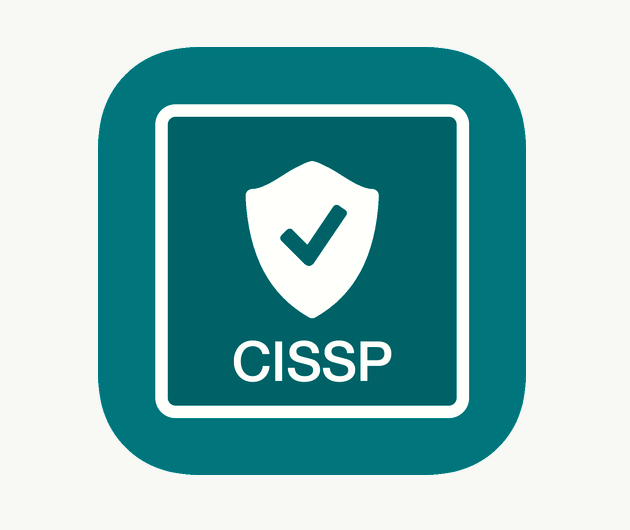CISSP - Question Bank 16
Test your knowledge of CISSP with these multiple choice questions. Each Question Bank includes 20 practice questions that have been designed to measure your knowledge of key ideas.
A key factor to keep in mind is that guessing is better than not answering a question.
Every single question on the CISSP exam is a four-option multiple choice question with a single correct answer. Some are straightforward, such as asking you to select a definition. Some are a bit more involved, such as asking you to select the appropriate concept or best practice. And some questions present you with a scenario or situation and ask you to select the best response.
StartQ1. What is the end goal of Disaster Recovery Planning?
A. Preventing business interruption
B. Setting up temporary business operations
C. Restoring normal business activity
D. Minimizing the impact of a disaster
Q2. Which one of the following is an example of a man-made disaster?
A. Tsunami
B. Earthquake
C. Power outage
D. Lightning strike
Q3. According to the Federal Emergency Management Agency, approximately what percentage of U.S. states is considered to have at least a moderate risk of seismic activity?
A. 20 percent
B. 40 percent
C. 60 percent
D. 80 percent
Q4. Which one of the following disaster types is not normally covered by standard business or homeowner's insurance?
A. Earthquake
B. Flood
C. Fire
D. Theft
Q5. In the wake of the September 11, 2001 terrorist attacks, what industry made drastic changes that directly impact DRP/BCP activities?
A. Tourism
B. Banking
C. Insurance
D. Airline
Q6. Which one of the following statements about Business Continuity Planning and Disaster Recovery Planning is not correct?
A. Business Continuity Planning is focused on keeping business functions uninterrupted when a disaster strikes.
B. Organizations can choose whether to develop Business Continuity Planning or Disaster Recovery Planning plans.
C. Business Continuity Planning picks up where Disaster Recovery Planning leaves off.
D. Disaster Recovery Planning guides an organization through recovery of normal operations at the primary facility.
Q7. What does the term "100-year flood plain" mean to emergency preparedness officials?
A. The last flood of any kind to hit the area was more than 100 years ago.
B. A flood is expected to hit the area once every 100 years.
C. The area is expected to be safe from flooding for at least 100 years.
D. The last significant flood to hit the area was more than 100 years ago.
Q8. In which one of the following database recovery techniques is an exact, up-to-date copy of the database maintained at an alternative location?
A. Transaction logging
B. Remote journaling
C. Electronic vaulting
D. Remote mirroring
Q9. What disaster recovery principle best protects your organization against hardware failure?
A. Consistency
B. Efficiency
C. Redundancy
D. Primacy
Q10. What Business Continuity Planning technique can help you prepare the business unit prioritization task of Disaster Recovery Planning?
A. Vulnerability Analysis
B. Business Impact Assessment
C. Risk Management
D. Continuity Planning
Q11. Which one of the following alternative processing sites takes the longest time to activate?
A. Hot site
B. Mobile site
C. Cold site
D. Warm site
Q12. What is the typical time estimate to activate a warm site from the time a disaster is declared?
A. 1 hour
B. 6 hours
C. 12 hours
D. 24 hours
Q13. Which one of the following items is a characteristic of hot sites but not a characteristic of warm sites?
A. Communications circuits
B. Workstations
C. Servers
D. Current data
Q14. What type of database backup strategy involves bulk transfers of data to a remote site on a periodic basis but does not involve maintenance of a live backup server at the remote site?
A. Transaction logging
B. Remote journaling
C. Electronic vaulting
D. Remote mirroring
Q15. What type of document will help public relations specialists and other individuals who need a high-level summary of disaster recovery efforts while they are underway?
A. Executive summary
B. Technical guides
C. Department-specific plans
D. Checklists
Q16. What Disaster Recovery Planning tool can be used to protect an organization against the failure of a critical software firm to provide appropriate support for their products?
A. Differential backups
B. Business Impact Assessment
C. Incremental backups
D. Software escrow agreement
Q17. What type of backup involves always storing copies of all files modified since the most recent full backup?
A. Differential backups
B. Partial backup
C. Incremental backups
D. Database backup
Q18. What combination of backup strategies provides the fastest backup creation time?
A. Full backups and differential backups
B. Partial backups and incremental backups
C. Full backups and incremental backups
D. Incremental backups and differential backups
Q19. What combination of backup strategies provides the fastest backup restoration time?
A. Full backups and differential backups
B. Partial backups and incremental backups
C. Full backups and incremental backups
D. Incremental backups and differential backups
Q20. What type of disaster recovery plan test fully evaluates operations at the backup facility but does not shift primary operations responsibility from the main site?
A. Structured walk-through
B. Parallel test
C. Full-interruption test
D. Simulation test
- Question Bank 00
- Question Bank 01
- Question Bank 02
- Question Bank 03
- Question Bank 04
- Question Bank 05
- Question Bank 06
- Question Bank 07
- Question Bank 08
- Question Bank 09
- Question Bank 10
- Question Bank 11
- Question Bank 12
- Question Bank 13
- Question Bank 14
- Question Bank 15
- Question Bank 16
- Question Bank 17
- Question Bank 18
- Question Bank 19


